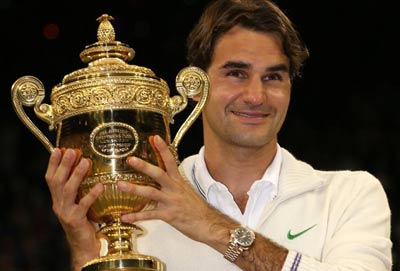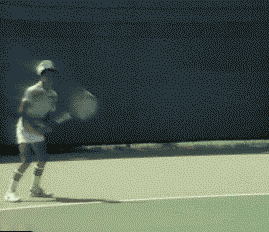|
TennisOne Lessons In Defense of the One-Handed Topspin Backhand Daryl Fisher To defend tennis’s one-handed topspin backhand might seem very strange to many of you given that the current number one male player in the world, and arguably the greatest player ever, Roger Federer, uses one. Despite this, I have recently heard the two-handed backhand promoted as somehow superior.
For the sake of those with the one-hander, for those that are considering which backhand to use, and for those that would despair for the most beautiful shot in tennis if it were to disappear, I would like to remind you that most knowledgeable coaches will convey pros and cons, not that one is superior. Though they have different attributes, please feel secure that the one-hander still holds the place of at least the equal of the two-hander in terms of effectiveness. Two-Handed Forehand?The trouble with nearly all of the arguments for the superiority of the two-handed backhand is that if you listen to them closely, they could also be used to argue for the superiority of the two-handed forehand over the one-handed forehand as well. I am not opposed to the two-handed forehand, but most of us understand more clearly on the forehand side that if we can achieve sufficient stability with the one-handed forehand, then the one-handed forehand gives us the benefit of being able to reach farther. The same is true for the one-handed backhand relative to the two-handed backhand. Stability with the two-handed backhand is fairly straightforward, whereas in the early stages of learning a one-handed backhand, stability is initially a bit tougher to consistently achieve. In the face of that initial challenge, many people opt for the two-handed backhand. To opt for the two-handed backhand is not wrong, but the point is that with good coaching and a little patience, the one-handed backhand can be at least as effective.
High Backhands Some people talk about the challenge of high backhands as if to argue that all that is required to beat Federer at the French Open is to hit high backhands to him. This seems to neglect the fact that Federer has been fairly dominant on clay for the bulk of the last decade with the exception of Rafael Nadal. Of course tennis fans cite the high backhand as the primary reason that Nadal can beat Federer at the French Open, forgetting that there are other factors complicating the match up, not least of which is that Nadal is a right-hander who plays left-handed; thus, with the two-handed backhand, he essentially has two forehands. Comparing backhands is speculation at best. I will not tell you that high one-handed topspin backhands are easy, but I would not say that of high two-handed backhands either. They are both tough! I guarantee that professional players know how to hit high balls to each others’ backhands, but when Justine Henin was blowing through the competition at the French Open, I did not hear her whine about how hard it was to be 5’ 6” with a one-handed backhand.
Her many accomplishments include four French Open titles, three of which were consecutive, and two of which she won without losing a set. She also holds the record for winning forty consecutive sets at the French Open, and she also reached the finals of all four majors in the year 2006. The argument that Henin’s or Federer’s records would be better if only they had two-handed backhands lacks substance. Bandwagon Fallacy The primary argument that is used to promote the two-hander as superior is the percentage of players using the two-hander in the pro ranks. While it is currently true that there are more players on the pro tour using the two-handed backhand, it is not clear that any conclusions can be drawn from the percentages. To do so would be an example of what is known as the bandwagon fallacy. This fallacy suggests that something is right or better or logically valid simply because it is popular. If a cause and effect relationship could be established simply through the percentage of players in the top 100 or top 10 using a particular stroke, it would have been established back in 1970 that the one-handed backhand was clearly superior. And of course many people then did assume then that the one-hander was better simply because most pro players used one. Bjorn Borg was even asked in an interview when he was going to switch to the obviously superior one-handed backhand.
There are people that will still cling to the percentages of top players using the two-handed backhand and claim that the rise of the two-hander is in response to changes in the game itself. Many things have certainly changed, but the percentages hardly indicate that the two-hander is better. For one, the percentages are not even that convincing. For example, as I write this the 2012 US Open is happening, and there are five men in the round of 16 that use one-handed backhands: Roger Federer, Nicolas Almagro, Philipp Kohlschreiber, Richard Gasquet, and Stanislas Wawrinka. There is also one woman in the final eight that uses the one-hander: Roberta Vinci. Also, even if 100% of all pros used a one or two-handed backhand, the conclusion that the stroke is superior would still not be warranted. There are simply too many other possible factors and explanations. I will explore a possible explanation in the next section. To the people that are still swayed by the percentages, I suspect what is known as a “confirmation bias,” which is favoring information and arguments that confirm their beliefs. As a possible remedy to this bias, I recommend reading chapter 8 on the post hoc fallacy in the book How to Lie with Statistics by Darrell Huff. “The moment we want to believe something, we suddenly see all the arguments for it, and become blind to the arguments against it.” –George Bernard Shaw Teaching Changed
There could be any number of reasons for the shift in the percentage of tennis players using one and two-handed backhands, but I suspect at the heart of it was a simple acceptance of the two-handed backhand. In 1970, the two-handed backhand was generally not taught at all. Now, as much as I revere the one-handed backhand, I admit that I personally teach the two-hander more because, as mentioned earlier, the two-handed backhand often seems easier to a novice. I have the strong suspicion that I am not alone in this. Though I am defending the one-handed backhand, I am not trying to downgrade the two-hander. In fact it is a fine shot (as is the two-handed forehand for that matter). Though I regularly let people try both the one-handed and the two-handed backhands, tennis is a difficult game (often competing with other sports for attention), so I gladly teach the two-hander if it fosters early success for the sake of someone’s interest in the game. So regarding the lower percentages of players using a one-handed backhand on the court, could a possible explanation simply be that more players are being taught the two-handed backhand (especially when they are young) accounting for their greater numbers on the pro tour? Furthermore, with fewer players being taught the one-handed backhand, could that in turn perpetuate a cycle in which there are fewer and fewer instructors and coaches able to teach the stroke? Reach: a Distinct Advantage My anecdotal evidence from past students is that the one-handed backhand takes a bit longer to develop, but that when it does develop the user typically enjoys a number of noteworthy benefits. The primary benefit is substantial and undeniable: additional reach. As a personal digression (and a digression for those of you that might have read my article Suggestions for Better Tennis after the Age of 40), as I age while playing this sport for a lifetime, I am increasingly happy about having a one-handed backhand for the sake of the additional reach. At the very least all players should own a one-handed underspin backhand for this benefit.
Challenges Allow me to finish my defense of the one-handed topspin backhand with a few challenges for instructors and coaches, parents, and players. Instructors and coaches, I understand that the two-handed backhand is easier to teach and that it might suit some students just fine, but I would like to challenge us to consider which of our players might benefit from learning the one-handed backhand. Also please consider, do you automatically have children (especially younger children) play with a two-handed backhand? And when was the last time that you taught a girl to use a one-hander? Parents, did your child learn a two-handed backhand by virtue of starting very young? Though a two-handed backhand might suit your child, if you weigh the pros and cons and decide that a one-handed backhand is a better fit, the challenge for you may be to find an environment conducive for your child to learn a proper one-handed backhand. Where your child plays, do you look around and see only two-handed backhands? Players, the one-handed backhand might be difficult to learn at first, so one challenge is whether you are the sort of person that can maintain determination in the face of an initially steeper learning curve. Then, will your coach teach you a one-handed backhand? Does your coach care more about short-term success, or will you receive the support you need to make a switch? Overview By my defending the one-handed topspin backhand, you might have noticed that I am not downgrading the two-handed backhand. To discuss the countless pros and cons of each stroke would go far beyond the scope of this article. Both are fine shots. It should also be clear, however, that the one-hander is at least as good, particularly with reach as an undeniable and substantial advantage. For some people, especially beginners, the one-hander does offer the challenge of finding as much stability, so learning the stroke’s stable alignment is crucial. I gladly accept writing about the one-handed topspin backhand’s stable alignment as my next writing assignment. |


